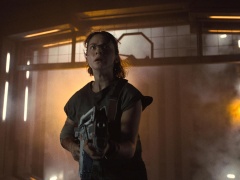
Every great screen performance expands the medium in its own way, giving audiences something to respond to, while offering fresh ideas to future actors. A select few can be said to have redefined the craft entirely: Orson Welles in “Citizen Kane,” Marlon Brando in “On the Waterfront,” Toshiro Mifune in “Rashomon” and Gena Rowlands in “A Woman Under the Influence.”
Rowlands died Wednesday at age 94, half a century after “A Woman Under the Influence” premiered at the New York Film Festival in 1974. Rowlands was the last to go from among a tight clique of titans —actors who transformed modern cinema: Peter Falk, Seymour Cassel, Ben Gazzara and, of course, Rowlands’ late husband, actor-director John Cassavetes.
Take-Two Earnings Emblematic of Endless Risk-Taking in Gaming Biz

Tim Walz Says He Looks Forward to Debating JD Vance If He'll 'Get Off the Couch'
Younger audiences who know Rowlands only as the memory-challenged older woman in “The Notebook” (directed by her son Nick Cassavetes) or for her Emmy-winning turn in “Hysterical Blindness” owe it to themselves to investigate her most important work, including formidable turns in “Faces,” “Opening Night” and “Gloria” (the most mainstream-friendly of those titles, in which she plays a pistol-packing gangster’s moll charged with protecting a Puerto Rican orphan). My personal favorite is 1971’s almost-impossible-to-find “Minnie and Moskowitz,” if only because the shaggy central couple, played by Rowlands and Cassel, struggle in such recognizably human ways.
Gina was there from the beginning of her husband John’s filmmaking career, witnessing firsthand what is widely recognized as the birth of the American independent film movement. Technically, Rowlands was on stage, acting opposite Edward G. Robinson in “Middle of the Night,” when Cassavetes made “Shadows.” (She does appear briefly in the film, but made a far greater impression in the nine other movies they made together.) Rowlands served as his muse, and without such a force to inhabit her roles, Cassavetes’ oeuvre would not have had the seismic influence on the course of screen acting.
Before moving on to “A Woman Under the Influence,” it’s worth taking a moment to consider the impact of “Shadows” on both Cassavetes’ and Rowlands’ careers. Shot in 1957 for just $40,000, the black-and-white film was an experiment in improvisation-based acting, which grew out of a workshop exercise between Cassavetes and his cast. The performances in that movie are raw, fiery and seemingly unrehearsed (even though some required as many as 50 takes to satisfy the perfectionist first-time filmmaker), introducing a new kind of realism to screen acting.
According to Rowlands (who served as a sort of living memory for her husband after his death in 1989), Cassavetes wrote detailed scripts for nearly all his subsequent projects. And yet, “Shadows” made such a revolutionary impression on the filmmaking community at the time that Cassavetes’ name came to be associated with improvisation, such that audiences assumed those projects were made the same way (where actors were responsible for their own dialogue), to the extent that many directors have credited Cassavetes as the pioneer of their own improv-based approaches.
The truth is more nuanced, but also essential to understanding Rowlands’ power as an actor. Given his own background (he played Mia Farrow’s husband in “Rosemary’s Baby” the same year he made “Faces”), Cassavetes was the apotheosis of an “actor’s director.” He implicitly trusted those he’d cast in his films to make the characters their own, listening to their suggestions and encouraging whatever original ideas they might bring.
In a video interview with the Academy, Rowlands describes a liberating lesson her husband gave her on “A Woman Under the Influence.” Rowlands was second-guessing her ability to play the title character, and Cassavetes insisted that he’d written it for her. “The part belongs to you,” he told her, putting full trust in Rowlands to embody it. “It was the most wonderful feeling of freedom,” she explained. “It’s freed me up in many things since, so that when I hear the word ‘action,’ it’s not any pressure. [The part] is mine to do with what I think is right.”
The one caveat with Cassavetes: After “Shadows,” it always went back to the script, resulting in a highly disciplined form of improvisation that can fairly be compared to jazz. The performers learn their music, but are free to interpret and embellish in ways that make the result feel unpredictable and alive — in short, true to life.
In “A Woman Under the Influence,” Rowlands plays Mabel Longhetti, a modern housewife who sincerely wants to please her husband, but is overwhelmed by her three children, an intrusive mother-in-law and unattainable ideas of what a “perfect wife” should be. To put the film in context, “The Stepford Wives” (from “Rosemary’s Baby” writer Ira Levin) had landed two years earlier, which goes to show that society was questioning whether the notion of a “perfect wife” was a reasonable ideal.
Watching the film, one gets the impression that Mabel has been inundated by decades of Hollywood movies and Madison Avenue advertising — misleading, impossible depictions that present wives as submissive, supportive partners. Mabel desperately wants to serve that role to her husband Nick (Peter Falk), but has anxieties, alcohol abuse and other mental health obstacles standing in the way. During the film’s unhinged birthday party scene — in which some kids play dress up, while others run around completely naked — another parent berates Mabel for “acting strange,” which is ironic, since that’s precisely what makes her work in the film so special.
Until Rowlands played that character, the vast majority of screen performances could be described as “acting normal.” Some stars, like Rowlands’ idol Bette Davis (with whom she appeared in the TV movie “Strangers: The Story of a Mother and Daughter”), devoured a fair amount of scenery along the way, but they tended to avoid the kind of twitching, contorted agony we see on Rowlands’ face in scene after scene of “A Woman Under the Influence.”
Few had ever let audiences in to the slow, excruciating unraveling of a woman’s psyche the way Rowlands did. The most painful part — from the spaghetti breakfast she serves Nick and his buddies to the climactic slap — comes in knowing that Mabel is trying to keep it together. She wants to be the perfect wife.
“Tell me what you want me to… how you want me to be,” she stammers to her husband early on, pleading, “I can be that. I can be anything. You tell me, Nicky.” Rowlands possessed the range to play anybody, but poor Mabel doesn’t. She can only be herself, rendered human and recognizable in all her flaws.






